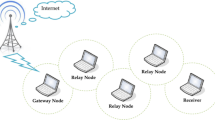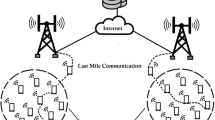Abstract
In this paper, we study the effects of network asymmetry on end‐to‐end TCP performance and suggest techniques to improve it. The networks investigated in this study include a wireless cable modem network and a packet radio network, both of which can form an important part of a mobile ad hoc network. In recent literature (e.g., [18]), asymmetry has been considered in terms of a mismatch in bandwidths in the two directions of a data transfer. We generalize this notion of bandwidth asymmetry to other aspects of asymmetry, such as latency and media‐access, and packet error rate, which are common in wide‐area wireless networks. Using a combination of experiments on real networks and simulation, we analyze TCP performance in such networks where the throughput achieved is not solely a function of the link and traffic characteristics in the direction of data transfer (the forward direction), but depends significantly on the reverse direction as well. We focus on bandwidth and latency asymmetries, and propose and evaluate several techniques to improve end‐to‐end performance. These include techniques to decrease the rate of acknowledgments on the constrained reverse channel (ack congestion control and ack filtering), techniques to reduce source burstiness when acknowledgments are infrequent (TCP sender adaptation), and algorithms at the reverse bottleneck router to schedule data and acks differently from FIFO (acks‐first scheduling).
Similar content being viewed by others
References
A. Bakre and B.R. Badrinath, Handoff and system support for indirect TCP/IP, in: Proc. 2nd Usenix Symp. on Mobile and Location-Independent Computing (April 1995).
H. Balakrishnan, Challenges to reliable data transport over heterogeneous wireless networks, Ph.D. thesis, University of California at Berkeley (August 1998). Also available as Technical Report UCB/CSD–98–1010.
H. Balakrishnan, V.N. Padmanabhan, S. Seshan and R.H. Katz, Comparing the performance of transport protocols in wireless networks, in: Proc. ACM SIGCOMM '96 (August 1996).
H. Balakrishnan, S. Seshan and R.H. Katz, Improving reliable transport and handoff performance in cellular wireless networks, Wireless Networks 1(4) (December 1995).
Berkeley Software Design, Inc. http://www.bsdi.com.
R. Caceres and L. Iftode, Improving the performance of reliable transport protocols in mobile computing environments, IEEE J. Selected Areas in Communications 13(5) (June 1995).
S. Cheshire and M. Baker, A wireless network in MosquitoNet, IEEE Micro (February 1996).
D.-M. Chiu and R. Jain, Analysis of the increase and decrease algorithms for congestion avoidance in computer networks, Computer Networks and ISDN Systems 17 (1989) 1–14.
R. Durst, G. Miller and E. Travis, TCP extensions for space communications, in: Proc. ACM Mobicom Conference (November 1996).
R. Fielding, J. Gettys, J. Mogul, H. Frystyk and T. Berners-Lee, Hypertext transfer protocol – HTTP/1.1. RFC, RFC-2068 (January 1997).
S. Floyd and V. Jacobson, Random early detection gateways for congestion avoidance, IEEE/ACM Trans. Networking 1(4) (August 1993) 397–413.
V. Jacobson, Congestion avoidance and control, in: Proc. ACM SIGCOMM 88 (August 1988).
V. Jacobson, Compressing TCP/IP Headers for Low-Speed Serial Links, RFC 1144 (February 1990).
R. Jain, The Art of Computer Systems Performance Analysis (Wiley, 1991).
L. Kalampoukas, A. Varma and K.K. Ramakrishnan, Performance of two-way TCP traffic over asymmetric access links, in: Proc. Interop '97 Engineers' Conf. (May 1997).
P. Karn, MACA – A new channel access method for packet radio, in: Proc. 9th ARRL Computer Networking Conf. (1990).
P. Karn, Dropping TCP acks. Mail to the end-to-end mailing list (February 1996).
T.V. Lakshman, U. Madhow and B. Suter, Window-based error recovery and flow control with a slow acknowledgement channel: A study of TCP/IP performance, in: Proc. Infocom 97 (April 1997).
M.K. McKusick, K. Bostic, M.J. Karels and J.S. Quarterman, The Design and Implementation of the 4.4 BSD Operating System (Addison–Wesley, Reading, MA, 1996).
UCB/LBNL/VINT Network Simulator – ns, Version 2, http://wwwmash. cs.berkeley.edu/ns/.
V.N. Padmanabhan, Addressing the Challenges of Web Data Transport. Ph.D. thesis, University of California at Berkeley (September 1998). Also available as Technical Report UCB/CSD-98–1016.
V.N. Padmanabhan, H. Balakrishnan, K. Sklower, E. Amir and R.H. Katz, Networking using direct broadcast satellite, in: Proc. Workshop on Satellite-Based Information Systems (November 1996).
V.N. Padmanabhan and J.C. Mogul, Improving HTTP latency, in: Proc. 2nd Int. World Wide Web Conf. (October 1994).
L. Zhang, S. Shenker and D.D. Clark, Observations and dynamics of a congestion control algorithm: The effects of two-way traffic, in: Proc. ACM SIGCOMM '91 (1991) pp. 133–147.
Author information
Authors and Affiliations
Rights and permissions
About this article
Cite this article
Balakrishnan, H., Padmanabhan, V.N. & Katz, R.H. The effects of asymmetry on TCP performance. Mobile Networks and Applications 4, 219–241 (1999). https://doi.org/10.1023/A:1019155000496
Issue Date:
DOI: https://doi.org/10.1023/A:1019155000496




